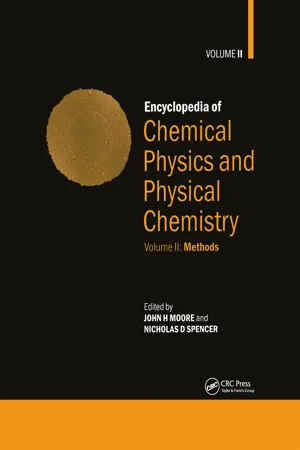
eBook - ePub
Encyclopedia of Chemical Physics and Physical Chemistry
Volume 2: Methods
This is a test
- 938 pages
- English
- ePUB (mobile friendly)
- Available on iOS & Android
eBook - ePub
Encyclopedia of Chemical Physics and Physical Chemistry
Volume 2: Methods
Book details
Table of contents
Citations
About This Book
The Encyclopedia of Physical Chemistry and Chemical Physics introduces possibly unfamiliar areas, explains important experimental and computational techniques, and describes modern endeavors. The encyclopedia quickly provides the basics, defines the scope of each subdiscipline, and indicates where to go for a more complete and detailed explanation. Particular attention has been paid to symbols and abbreviations to make this a user-friendly encyclopedia. Care has been taken to ensure that the reading level is suitable for the trained chemist or physicist. The encyclopedia is divided in three major sections:
- FUNDAMENTALS: the mechanics of atoms and molecules and their interactions, the macroscopic and statistical description of systems at equilibrium, and the basic ways of treating reacting systems. The contributions in this section assume a somewhat less sophisticated audience than the two subsequent sections. At least a portion of each article inevitably covers material that might also be found in a modern, undergraduate physical chemistry text.
- METHODS: the instrumentation and fundamental theory employed in the major spectroscopic techniques, the experimental means for characterizing materials, the instrumentation and basic theory employed in the study of chemical kinetics, and the computational techniques used to predict the static and dynamic properties of materials.
- APPLICATIONS: specific topics of current interest and intensive research.For the practicing physicist or chemist, this encyclopedia is the place to start when confronted with a new problem or when the techniques of an unfamiliar area might be exploited. For a graduate student in chemistry or physics, the encyclopedia gives a synopsis of the basics and an overview of the range of activities in which physical principles are applied to chemical problems. It will lead any of these groups to the salient points of a new field as rapidly as possible and gives pointers as to where to read about the topic in more detail.
Frequently asked questions
At the moment all of our mobile-responsive ePub books are available to download via the app. Most of our PDFs are also available to download and we're working on making the final remaining ones downloadable now. Learn more here.
Both plans give you full access to the library and all of Perlego’s features. The only differences are the price and subscription period: With the annual plan you’ll save around 30% compared to 12 months on the monthly plan.
We are an online textbook subscription service, where you can get access to an entire online library for less than the price of a single book per month. With over 1 million books across 1000+ topics, we’ve got you covered! Learn more here.
Look out for the read-aloud symbol on your next book to see if you can listen to it. The read-aloud tool reads text aloud for you, highlighting the text as it is being read. You can pause it, speed it up and slow it down. Learn more here.
Yes, you can access Encyclopedia of Chemical Physics and Physical Chemistry by John H. Moore, Nicholas D. Spencer in PDF and/or ePUB format, as well as other popular books in Physical Sciences & Physical & Theoretical Chemistry. We have over one million books available in our catalogue for you to explore.
Information
Table of contents
- Cover
- Half Title
- Title Page
- Copyright Page
- Table of Contents
- Part B1 Determining Materials and Molecular Properties
- Part B2 Dynamic Measurements
- Part B3 Techniques for Applying Theory